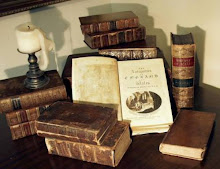The Renaissance provided the backdrop for the height of popularity of what is known as the commonplace book. The times had seen a sudden flood of information, and commonplace books became one means of organizing and remembering items of personal significance. Wikipedia broadly defines commonplace books as "essentially scrapbooks filled with items of every kind: medical recipes, letters, poems, tables of weights and measures, proverbs, prayers, legal formulas."
The term was originally one of rhetoric, signifying a passage that could be generally applied in the locus communis, or the common place. By using these books to record items of particular interest, readers became the center of their own books, what Barbara M. Benedict, in Making the Modern Reader: Cultural Mediation in Early Modern Literary Anthologies, calls "the locus of meaning from which the collected texts differ." For the average reader who recorded their thoughts and criticisms with each passage, these books became a social skill as well as a personal pleasure. And though many modern researchers pay them scant attention, such commonplace books are printed guides to the cultures of their times.
The 2001 exhibition Commonplace Books: Manuscripts and Printed Books from Antiquity to the Twentieth Century, at the Beinecke Library at Yale University featured the collections of Seneca, Saint Bernard de Clairvaux, John Locke, Edward Gibbon, and W.H. Auden among many others. But, in Bell's Common Place Book, for the Pocket: Form'd generally upon the Principles Recommended and Practiced by Mr. Locke (London: 1770), John Bell noted that a commonplace book
...is not solely for the Divine, the Lawyer, the Poet, Philosopher, or Historian. . . . It is for the use and emolument of the man of business as well as of letters; for men of fashion and fortune as well as of study; for the Traveller, the Trader, and in short for all those who would form a system of useful and agreeable knowledge, in a manner peculiar to themselves, while they are following their accustomed pursuits, either of profit or pleasure.
Dougj provides a fine explanation of commonplace books, and how to make and use one, in One and Two parts. His site also gives one a good sense of how a commonplace book was normally organized, with each entry indexed by heading for easy reference. He cites Robert Darnton ("Extraordinary Commonplaces," The New York Review of Books, December 21, 2000), who said that, for compilers of commonplace books, reading and writing were inseperable acts in an effort to make sense of things. In other words, keeping a commonplace book was a way of damming up the stream of experience and swimming in it, another necessary act of devotion.
Darnton goes on to say that "commonplacing as a practice probably began in the twelfth century and remained widespread among the Victorians. It disappeared long before the advent of the sound bite." Perhaps he hasn't visited any of the blogs Your Bibliothecary noted at the start. What more is there to blogging than copying a pithy passage under an appropriate heading and adding observations made in the course of daily life?
The allure of the weblog today is the same as the allure of Bell's blank manuscript books that offered a person the opportunity to participate in printed culture, both as writers and readers of their own identity. His quote, too, would fit well in any blog's "ABOUT" category. Thus we come to know ourselves and one another with each blog entry, posting, or chapter--literal entries into the thoughts and feelings of the person who wrote them.
We embrace the digital age and call it our own, but the roots are firmly planted in the Renaissance, and we find ourselves now still coming to understand the universe and our place in it by means no different than people did then.


I don't think I have ever been mentioned in the same breath as Mr. Milton and Mr. Bacon. I am, of course, highly flattered.
ReplyDeleteAlso I think you are absolutely right. Even a quick scan of the litblogs out there shows a huge quantity of (mostly) excellent thinking and writing.